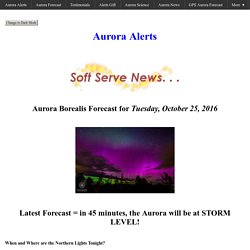

Aurora Borealis Activity Now. Everything You Need to know. By JIM THOMAS -- Soft Serve News Auroras are difficult to predict with precision.

They have stops and starts (known as sub-storms). If you are out there, you need to be patient and lucky. Here are some tools that will increase your chances. Here is the prediction of storm intensity for the next few minutes (the higher the Kp number, the larger the Aurora): The Space Environment Center's Neural Net Program estimates that . . . in 15 minutes, the Geomagnetic Activity level (Kp number) will be 7 -- at STORM LEVEL! Why miss your Aurora? Now, find the Kp number line on one of the following maps that matches the Kp number predicted above. It's critical to get confirmation of activity with NOAA's Ovation map. It's a great sign if you see a thick aurora band with some areas of light yellow, orange or, better yet, RED on this map as opposed to just a thin (or transparent) band with only dark green. (Story continues below) Want free access to the Aurora three day forecast?
Dark. Why? The Scale of the Universe 2. Using physics and estimation to assess energy, growth, options—by Tom Murphy. It’s a bit off-topic for the series, but I can’t even go to Google now without being reminded of the World Cup and soccer this, soccer that.

(Apologies to non-Americans who know the sport as football—but don’t get me started on football!) I have often wondered: given characteristic low score values, is soccer anything more than Poisson noise? When discussing this with colleagues, one pointed me to this XKCD comic, reproduced at right. Any random process that produces discrete events in some time interval, with uniform probability per unit time follows a Poisson distribution. When the number of events becomes large, the distribution tends toward a Gaussian (normal) distribution. My thesis is that soccer is an amalgam of random processes whose net effect produces rare events—those more-or-less unpredictable events spread more-or-less uniformly in time. Normally I allow comments on Do the Math for ten days after each post. Continue reading. Edge : Conversations on the edge of human knowledge.
Conversations About Science with Theoretical Physicist Matt Strassler. Science news and science jobs from New Scientist. Bad Astronomy. Well now, this is an interesting discovery: astronomers have found what looks like a "super-Earth" – a planet more massive than Earth but still smaller than a gas giant – orbiting a nearby star at the right distance to have liquid water on it!

Given that, it might – might – be Earthlike. This is pretty cool news. We’ve found planets like this before, but not very many! And it gets niftier: the planet has at least five siblings, all of which orbit its star closer than it does. Now let me be clear: this is a planet candidate; it has not yet been confirmed. The star is called HD 40307, and it’s a bit over 40 light years away (pretty close in galactic standards, but I wouldn’t want to walk there).
Massive planets tug on their star harder, so they’re easier to find this way. In this case, HD 40307 was originally observed a little while back by HARPS, and three planets were found. We don’t know how big the planet is, unfortunately. That’s exciting because of the prospect for life.